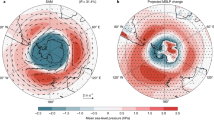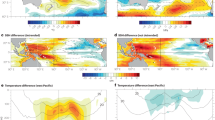Abstract
THE distribution of tropical sea surface temperatures (SSTs) is negatively skewed: a 'warm pool' with SSTs greater than 300.5 K covers roughly half the tropical oceans (15° N to 15° S), whereas SSTs as low as 293 K are observed in regions of equatorial and coastal upwelling and persistent stratus cloud cover1. SSTs are thus within 2–3 K of the highest values over a large area of the tropical ocean, leading some authors to suggest that some physical process may act to limit SSTs to below about 303 K. Ramanathan and Collins2 have proposed a 'thermostat' mechanism in which ocean warming produces enhanced deep convection, leading to the formation of extensive cirrus cloud canopies which shield the troposphere and ocean surface from incoming solar radiation. Here I suggest that a mechanism of this sort may not be required to explain the SST distribution. I argue that large-scale dynamical processes will act to maintain uniform tropical tropospheric temperatures to within about 2 K, and that, in the absence of horizontal temperature contrasts in the atmosphere, a negatively skewed SST frequency distribution is bound to develop through equilibration between the atmosphere and spatially varying SSTs. In addition, although cirrus clouds reduce the solar insolation at the Earth's surface in regions of deep convection, they would not necessarily prevent SSTs from exceeding 305 K in the face of extensive greenhouse warming.
This is a preview of subscription content, access via your institution
Access options
Subscribe to this journal
Receive 51 print issues and online access
$199.00 per year
only $3.90 per issue
Buy this article
- Purchase on Springer Link
- Instant access to full article PDF
Prices may be subject to local taxes which are calculated during checkout
Similar content being viewed by others
References
Sadler, J. C. Lander, M. A., Hori, A. M. & Oda, L. K. Tropical Mean Climatic Atlas Vols 1 and 2 UHMET 87-01 and 87-02 (Department of Meteorology, Univ. of Hawaii, 1987).
Ramanathan, V. & Collins, W. Nature 351, 27–32 (1991).
Newell, R. E., Navato, A. R. & Hsiung, J. Pure appl. Geophys. 116, 351–371 (1978).
Schneider, E. K. J. atmos. Sci. 34, 280–297 (1977).
Held, I. M. & Hou, A. Y. J. atmos. Sci. 37, 515–533 (1978).
Lindzen, R. S. & Hou, A. Y. J. atmos. Sci. 45, 2416–2427 (1988).
Sarachik, E. S. Dyn. Atm. Oceans 2, 455–469 (1978).
Japan Meteorological Agency Monthly Report on the Climate System Tech. note 35 (Tokyo. 1992).
Newell, R. E., Kidson, J. W., Vincent, D. G. & Boer, G. J. The General Circulation of the Tropical Atmosphere Vol. I (MIT Press, Cambridge, Massachusetts, 1972).
Author information
Authors and Affiliations
Rights and permissions
About this article
Cite this article
Wallace, J. Effect of deep convection on the regulation of tropical sea surface temperature. Nature 357, 230–231 (1992). https://doi.org/10.1038/357230a0
Received:
Accepted:
Issue Date:
DOI: https://doi.org/10.1038/357230a0
This article is cited by
-
Simple physical-empirical model of the precipitation distribution based on a tropical sea surface temperature threshold and the effects of climate change
Climate Dynamics (2018)
-
Multi-scale variation of the meridional movement of the western Pacific warm pool and its associated large-scale climate features
Theoretical and Applied Climatology (2017)
-
Climatology of hot events in the western equatorial Pacific
Journal of Oceanography (2015)
-
Different influences of two types of El Niños on the Indian Ocean SST variations
Theoretical and Applied Climatology (2014)
-
Evaluation of clouds and radiative fluxes in the EC-Earth general circulation model
Climate Dynamics (2014)
Comments
By submitting a comment you agree to abide by our Terms and Community Guidelines. If you find something abusive or that does not comply with our terms or guidelines please flag it as inappropriate.



